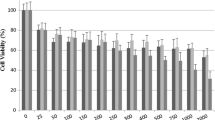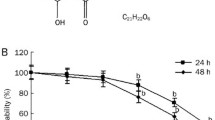Abstract
Khz, a naturally occurring compound derived from the fusion of Ganoderma lucidum and Polyporus umbellatus mycelia, inhibits the growth of cancer cells. This study aimed to investigate the anti-proliferative effects of Khz on A549 lung cancer cells. Khz cytotoxicity was measured using an MTT assay and the mitochondrial membrane potential (MMP)-related, calcium-induced generation of reactive oxygen species (ROS) in A549 cells was measured by flow cytometry. The expression of p53, Bax, Bcl-2, and actin proteins was analyzed by western blotting. Khz inhibited cell division and induced apoptosis in A549 cells. Flow cytometry analysis showed that the percentage of A549 cells in sub-G1 phase of the cell cycle increased in response to Khz treatment. Khz reduced MMP and Bcl-2 protein levels, but increased ROS generation and p53 and pro-apoptotic proteins. The anti-proliferative and pro-apoptotic effects of Khz suggest that this extract shows great promise as a potential chemotherapeutic agent.
Similar content being viewed by others
Refrerences
Lin ZB, Zhang HN. Anti-tumor and immunoregulatory activities of Ganoderma lucidum and its possible mechanisms. Acta Pharmacol. Sin. 25: 1387–1395 (2004)
Sandodiya BS, Thakur GS, Baqhel RK, Prasad GB, Bisen PS. Ganoderma lucidum: A potent pharmacological macrofungus. Curr. Pharm. Biotechnol. 10: 717–742 (2009)
Gao Y, Gao H, Chan E, Tang W, Xu A, Yang H, Huang M, Lan J, Li X, Duan W, Xu C, Zhou S. Antitumor activity and underlying mechanisms of ganopoly,the refined polysaccarides extracted from Ganoderma lucidum, in mice. Immunol. Invest. 34: 171–198 (2005)
Yue GG, Fung KP, Tse GM, Leung PC, Lau CB. Comparative studies of various ganoderma species and their different parts with regard to antitumor and immunomodulating activities in vitro. J. Altern. Complement. Med. 12: 777–789 (2006)
IIIana-Esteban C. The fungus maitake (Grifola frondosa) and its therapeutic potential. Rev. Iberoam. Micol. 25: 141–144 (2008)
Jang KJ, Han MH, Lee BH, Kim BW, Kim CH, Yoon HM, Choi YH. Induction of apoptosis by ethanol extracts of Ganoderma lucidum in human gastric carcinoma cells. J. Acupunct. Meridian Stud. 3: 24–31 (2010)
Yue QX, Song XY, Ma C, Feng LX, Guan SH, Wu WY, Yang M, Jiang BH, Liu X, Cui YJ, Guo DA. Effects of triterpenes from Ganoderma lucidum on protein expression profile of HeLa cells. Phytomedicine 17: 606–613 (2010)
Zhao S, Ye G, Fu G, Cheng JX, Yang BB, Peng C. Ganoderma lucidum exerts anti-tumor effects on ovarian cancer cells and enhances their sensitivity to cisplatin. Int. J. Oncol. 38: 1319–1327 (2011)
Liu RM, Zhong JJ. Ganoderic acid Mf and S induce mitochondria mediated apoptosis in human cervical carcinoma HeLa cells. Phytomedicine 15: 349–355 (2011)
Li L, Li T, Wang XJ, Xu JP, Wang SG. Effects of Ganoderma lucidum spores on HepG2 cells proliferation and growth cycle. Zhong Yao Cai 31: 1514–1518 (2008)
Zhao YY, Chao X, Zhang Y, Lin RC, Sun WJ. Cytotoxic steroids from Polyporus umbellatus. Planta Med. 76: 1755–1758 (2010)
Ott M, Gogvadze V, Orrenius S, Zhivotovsky B. Mitochondria, oxidative stress and cell death. Apoptosis 12: 913–922 (2007)
Jacobson MD, Raff MC. Programmed cell death and Bcl-2 protection in very low oxygen. Nature 374: 814–816 (1995)
Kim TH, Kim Js, Kim Zh, Huang RB, Wang RS. Khz (fusion of Ganoderma lucidum and Polyporus umbellatus mycelia) induces apoptosis by increasing intracellular calcium levels and activating JNK and NADPH oxidase-dependent generation of reactive oxygen species. PLoS One. 7: e46208 (2012)
Ryter SW, Kim HP, Hoetzel A, Park JW, Nakahira K, Wang X, Choi AM. Mechanisms of cell death in oxidative stress. Antioxid. Redox Sign. 9: 49–89 (2007)
Buttke TM, Sandstrom PA. Oxidative stress as a mediator of apoptosis. Immunol. Today. 15: 7–10 (1994)
Jacobson MD. Reactive oxygen species and programmed cell death. Trends Biochem. Sci. 21: 83–86 (1996)
Miyajima, A, Nakashima J, Yoshioka K. Role of reactive oxygen species in cis-dichlorodiammineplatium-induced cytotoxicity on bladder cancer cells. Brit. J. Cancer 76: 206–210 (1997)
Zhou Y, Hileman EO, Plunkett W, Keating MJ, Huang P. Free radical stress in chronic lymphocytic leukemia cells and its role in cellular sensitivity to ROS-generating anticancer agents. Blood 101: 4098–4104 (2003)
Nicotera P, Orrenius S. The role of calcium in apoptosis. Cell Calcium 23: 173–180 (1998)
Granfeldt D, Samuelsson M, Karlsson A. Capacitative Ca2+ influx and activation of the neutrophil respiratory burst. Different regulation of plasma membrane- and granule-localized NADPHoxidase. J. Leukocyte Biol. 71: 611–617 (2002)
Wang G, Anrather J, Glass MJ, Tarsitano MJ, Zhou P, Frys KA, Pickel VM, Iadecola C. Nox2, Ca2+, and protein kinase C play a role in angiotensin II-induced free radical production in nucleus tractus solitaries. Hypertension 48: 482–489 (2006)
Author information
Authors and Affiliations
Corresponding author
Rights and permissions
About this article
Cite this article
Kim, T.H., Kim, J.S., Kim, Z.H. et al. Khz (fusion of ganoderma lucidum and Polyporus umbellatus mycelia) induces apoptosis in A549 human lung cancer cells by generating reactive oxygen species and decreasing the mitochondrial membrane potential. Food Sci Biotechnol 23, 859–864 (2014). https://doi.org/10.1007/s10068-014-0115-3
Received:
Revised:
Accepted:
Published:
Issue Date:
DOI: https://doi.org/10.1007/s10068-014-0115-3




